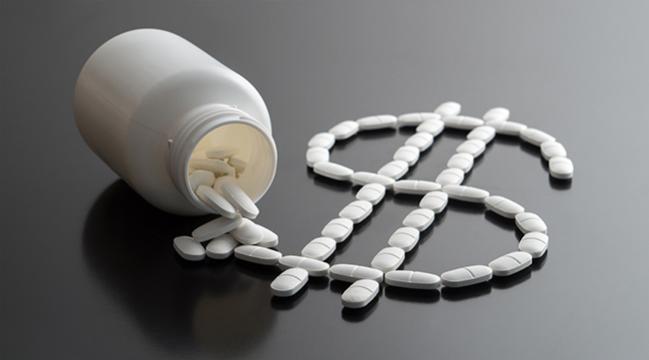Drugs Most Heavily Promoted by Pharma Don’t Necessarily Offer the Best Health Value
Top-selling and top-prescribed medications tend to score better than the most-promoted drugs on several metrics of value.

Pharmaceutical companies spend billions of dollars each year to promote their drugs to physicians and hospitals, but a new analysis suggests these products may not represent very good health value.
“Top-promoted drugs were less likely than top-selling and top-prescribed drugs to be effective, safe, affordable, [and] novel, and represent a genuine advance in treating a disease,” medical student Tyler Greenway and Joseph Ross, MD (Yale University School of Medicine), write in a paper published online ahead of print in the BMJ.
What that suggests, Ross told TCTMD, “is that physicians need to be more skeptical of pharmaceutical promotion and which drugs are being most heavily promoted to them, . . . because [they’re] not necessarily going to be the drugs that are of greatest value for patients.”
Physicians need to be more skeptical of pharmaceutical promotion and which drugs are being most heavily promoted to them. Joseph Ross
Prior studies have shown that more extensive interactions with drug sales representatives, as well as payments from industry, increase the likelihood that physicians will prescribe promoted brand-name medications over less expensive alternatives. Greenway and Ross wanted to take a deeper look at the health value of the drugs backed by the most promotional dollars.
To do so, they turned to the Open Payments Database, which was created as part of the Physician Payments Sunshine Act and provides publicly available information on industry payments to physicians. That database showed that between August 2013 and December 2014, pharmaceutical companies paid $3.53 billion to US physicians.
Using the Open Payments Explorer, a tool created by the nonprofit journalism group ProPublica to ease access to the database, Greenway and Ross identified the 25 drugs associated with largest total payments to physicians and teaching hospitals during that time period. That list included several cardiovascular medications: apixaban (Eliquis; Bristol-Myers Squibb), rivaroxaban (Xarelto; Janssen Pharmaceuticals), dabigatran (Pradaxa; Boehringer Ingelheim), ticagrelor (Brilinta; AstraZeneca), and tolvaptan (Samsca; Otsuka America Pharmaceutical).
They compared the top-promoted drugs with those topping charts for sales and prescriptions according to data from IMS Health in terms of health value. There was little overlap between the three lists, as only four (17%) of the top-promoted drugs were among the top sellers and none was on the most-prescribed list.
Because of the lack of good metrics for health value, Greenway and Ross created their own scheme based on the idea that “the ideal drug would be effective, safe, novel, recommended as first-line therapy for common diseases causing substantial morbidity and mortality, and affordable.”
Drugs were assessed to determine whether they are:
- Innovative: based on a schematic created by the US Food and Drug Administration (FDA)
- Effective and safe: based on ratings from the Prescrire International, a French drug industry watchdog
- Affordable: based on generic availability
- Clinically valuable: based on whether it is included on the list of essential medicines from the World Health Organization (WHO)
- First-line therapy: based on guidelines or UpToDate
“There’s definitely more to value than those five metrics,” Ross said, pointing to patient-centered outcomes like ease of use, “but we just thought that was a good starting point.”
In general, the top-promoted drugs fared worse in comparisons with the top-selling and top-prescribed medications, although the relationships did not always reach statistical significance.
For example, only 19% of the top-promoted drugs were rated by Prescrire International as being “possibly helpful” or “offers an advantage” compared with 44% of the top-selling drugs (P = 0.11) and 76% of the top-prescribed drugs (P < 0.001). And only one (4%) of the top-promoted drugs was on the WHO’s essential medicines list, compared with 36% of the top sellers (P = 0.01) and 56% of the most prescribed (P < 0.001).
“The top-promoted drugs tended to score lower on the different metrics of value,” Ross said. “They tended to be less innovative, they tended to be more expensive, and they tended to be less likely to be considered to have a new or important value for clinical care.”
On the other hand, “the drugs that do have great value [are] prescribed and adopted even without pharmaceutical promotion because physicians recognize their value,” he said.
Ross stated that the best way for clinicians to avoid being influenced by pharmaceutical promotion is to maintain a healthy skepticism.
“You just have to ask yourself the question, ‘Is this drug the best value for my patients against the other competing alternatives that are available?’ Sometimes the answer could be yes, but on average, our results suggest that the answer is probably going to be no,” he said.
Todd Neale is the Associate News Editor for TCTMD and a Senior Medical Journalist. He got his start in journalism at …
Read Full BioSources
Greenway T, Ross JS. US drug marketing: how does promotion correspond with health value? BMJ. 2017;357:j1855.
Disclosures
- Ross reports receiving research support through Yale University from Johnson & Johnson to develop methods of clinical trial data sharing; from Medtronic and the FDA to develop methods for postmarket surveillance of medical devices; from the FDA to establish a Center for Excellence in Regulatory Science and Innovation; from the Blue Cross Blue Shield Association to better understand medical technology evidence generation; from the Centers for Medicare & Medicaid Services to develop and maintain performance measures that are used for public reporting; and from the Laura and John Arnold Foundation to support the Collaboration on Research Integrity and Transparency at Yale.
- Greenway reports no relevant conflicts of interest.


Comments